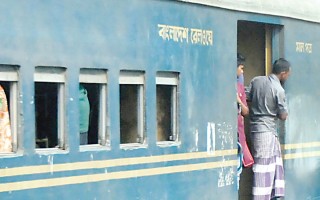BR faces occupancy crisis despite huge demand
Bangladesh Railway is yet to achieve 100 per cent occupancy of seats in intercity trains due to mismanagement, quota and corruption, officials and rights activists say.
Most of the vacant seats are in air-conditioned and first class compartments while the authorities are more interested to purchase AC coaches instead of non-AC general class ‘shovon’ coaches which carry most of the passengers.
A good many seats lie vacant when there is an overwhelming demand for train tickets.
According to BR, both in 2014-15 and 2015-16 fiscals, occupancy in air-conditioned class was around 43 per cent, in first class about 74 per cent and in ‘shovon’ class about 134 per cent in the intercity trains.
In 2017 the Eid-ul-Fitr and Eid-ul-Azha were celebrated on June 26 and September 2 respectively. In June of the year, the occupancy of AC class was 73 per cent, that first class 74 per cent and that of ‘shovon’ about 103 per cent in intercity trains.
In September of the same year, the occupancy in AC class was 84 per cent, in first class 92.5 per cent and in ‘shovon’ 122 per cent.
Tickets of AC and first class seats in most popular trains including Mohanagar Godhuli and Pravati, Joyontika, Ekota, Sundarban, Lalmoni, Silk City, Rangpur and Drutajan were also shown unsold in the occupancy lists of BR.
‘It is quite absurd that many AC tickets are not sold when they are golden tickets to common commuters like us,’ said Hamidur Rahman, a Dhaka resident.
According to BR’s traffic department, a train’s occupancy is calculated by its total seats and the number of unsold tickets.
BR additional director general Md Miajahan, however, differed saying that they counted occupancy with unsold tickets route-wise and station-wise.
On Dhaka-Chittagong route, all tickets for Dhaka-Bhairab stretch might be sold while only 60 per cent tickets might be sold for the Bhairab-Chittagong stretch, he explained.
In some trains occupancy would be low while in some the occupancy would be high, he continued.
‘We are under pressure at present due to dilapidated condition of roads,’ Miajahan said, adding, ‘To eight Tangail-route trains, we recently added 17 more compartments to cope up with the pressure of passengers.’
The officer claimed that one hour before any journey tickets for all vacant seats were made available on the counters.
Work for a Better Bangladesh, Trust project officer Atiqur Rahman termed the system for calculating occupancy in intercity trains faulty.
Despite huge demand for tickets, the authorities did not update its system to sell unsold tickets before journey, he said.
He alleged corruption in sale of ticket by employees such as travelling ticket examiners and guards who misappropriated passengers’ money by giving seats without tickets.
Quota system was also problematic for vacant seats as many VIPs might book seats and later cancel the booking, he pointed out.
If railway could achieve 100 per cent or more occupancy in its all classes, the gap between its revenue expenditure and earning would come down sharply, he observed.
‘There is always a huge demand for shovon seats while railways authorities are interested to buy AC compartments,’ he alleged.
National Committee to Protect Shipping, Roads and Railways general secretary Ashis Kumar Dey alleged that trains had vacant seats officially while practically these were not vacant.
Mismanagement and lack of coordination among railway staff were the reasons of low rate of occupancy, he said.
‘It is an ill attempt to project railway as a loss-incurring institution,’ he added.
News Courtesy: www.newagebd.net











